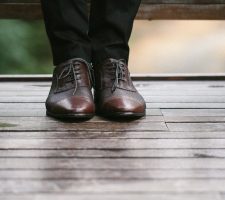If you live in a particularly wet country (UK maybe?), or if you have to walk to work through puddles, your expensive or less expensive shoes could pick up some water stains. A lot of the time these will just dry off and look like nothing has happened, but in some cases water stains can linger, making unsightly blemishes on your finest footwear.
There is no need to throw a fit, or your shoes in the bin – there are many ways of rescuing shoes that have a bit of water staining. Read on to learn how to remove water stains from leather shoes.
Let Them Dry Out Completely
One of your options, the very easiest of all, is to let them dry out completely. Some water stains will completely disappear, if they are small splashes or the leather hasn’t become completely saturated. You can help this process along with a hairdryer, or by leaving the shoes in a warm place, to get rid of all the excess moisture.
Stain Remover
You can, of course, buy a specialist stain remover for this very purpose, and for other issues that you may have with marks on your shoes. This is designed for this issue and very easy to use; you just follow the directions and enjoy watching the stains disappear before your very eyes.
Saddle Soap
Saddle soap is another good option. Designed for cleaning all types of muck from all types of leather, saddle soap will be gentle enough on your shoes but harsh enough on the stains to make your shoes look brand new again in no time.
It’s simple to use; simply moisten a cloth and rub it over the hard surface of the soap until you have a bit of a lather, then rub this mixture into the leather in small circular motions. It is a good idea to treat your shoes afterwards with a good leather conditioner, as saddle soap can be a bit drying.
Vinegar and Water
Some people opt for using a vinegar and water solution to answer the question how to remove water stains from leather shoes. This is another simple trick, and you might be more likely to have vinegar lying around in your cupboards than saddle soap!
All you need to do is wet a cloth under a tap, squeeze it out then dip it in vinegar, then squeeze it out again but not quite as hard, then rub the stain and leave the shoes for an hour. You should notice the stain disappearing before your very eyes! You want to make sure you don’t rub too hard or for too long, in case the astringent vinegar damages the finish of your shoes.
You Should Know That…
One of the added hazards with getting water stains in the winter is that the water that has splashed your shoes may have salt in it. This could come from road gritters, or simply people sprinkling salt on their driveways – either way, it’s not something you want on your shoes!
The vinegar and water solution is a great way of getting rid of salt stains, and there are further actions you can take if the damage has gone further.
Salt ridges are a problem that is harder to get rid of; once they’re set you’re stuck with them for life unless you take quick action. If you see salt ridges developing, simply rub at them with the back of a teaspoon until they disappear – it will take a bit of time but will be worth it in the end.
After you have done any kind of stain removing on your leather shoes, you should treat them with a really good leather conditioner to make sure the leather stays strong and supple, and is in the best condition it can be.
Leather conditioner is like a spa day for your shoes! It is a really good way of treating shoes, and will help them last for years to come.
Prevention is Key
The best way to remove water stains from leather shoes is to avoid getting water stains on them in the first place (I know, if you’re reading this then it’s a bit like shutting the stable door after the horse has bolted, but still!)
One of the best ways to avoid water damage to your favourite shoes is to wax and polish them regularly with a good, wax-based polish.
This type of shoe treatment has water-repelling properties, and although it cannot guarantee to protect your shoes from a downpour (or the accidental spilling of your lunchtime glass of water) it can help protect them a lot more than leaving them bare.
Whatever type of shoes you have, you should also always make sure you get your shoes dried off as quickly as possible after they have been splashed, to avoid the possibility of stains forming and being difficult to remove.
Another option, in a wet country like the UK, is to wear wellies to work and change quickly to your favourite Allen Edmonds, Church’s or Baker shoes in the lobby!


